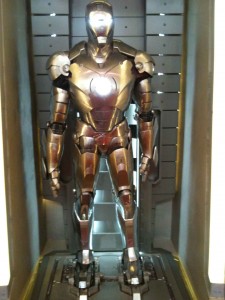Exadata V3 – Oops – EXADATA X2-8
Oracle had the new version of the Exadata Machine on display at Oracle Open World this week. It’s called the Exadata X2-8. That’s a catchy name. It sounds very Iron Manish! In fact they had these fellows on display next to the demo machines.
The X2-8 uses two 4U Sun Fire x4800 servers which each have 8 x eight-core intel CPUs (X7560) and 1 Terabyte of memory along with 14 Exadata Storage Servers. Here’s a link to the spec sheet for the X2-8 and for the Oracle Sun X4800. Below are a couple of pictures. The first one shows one of the database servers (X4800) with one of the CPU modules out.
The storage cells have not changed much from the original V2. They still have 2 CPUs and 12 drives and 384G of flash cache. Although I’ve been told they have newer (faster) 6 core Intel CPUs. (I did get a look at an unpublished spec sheet on an Oracle employee’s iPhone and it said they were using the 5670 CPUs) Oh, and they will allow you to run Solaris on the database servers. Of course they will have to finish a new version of Solaris 11 before that can happen. It’s worth noting that X2-8 can be ordered but that they don’t have a firm delivery date yet.
So this configuration is definitely for the high end market and addresses a couple of issues. The increased memory will allow us to have a more robust consolidation platform. It will also allow bigger OLTP type systems to run better (i.e. the additional memory means we can support many more concurrent users and have much larger buffer caches). Note that Exadata’s offloading generally reduces the memory requirements, but nevertheless, very large systems, particularly ones with lot’s of fast OLTP type transactions and lot’s of users will be better satisfied by this type of configuration. Also note that there is no little brother version of the X2-8. It comes in a full rack only. Which makes sense because there are only two database machines. I don’t believe the price has been set yet, but the word on the street is that the hardware will be about 50% more than the full rack version with the small 2 CPU blades (now renamed X2-2 by the way).
I did a post a couple of weeks ago (Thoughts on Exadata V3) about what I thought we might get to see in the way of Exadata changes. We got most of the things I was expecting but not all of them. Among the things we got are bigger/beefier servers with more memory and available slots for HBAs to provide some additional connection capabilities (although I’m not sure if Oracle is going to want people to open the machines up and put additional controllers in). I did see mention in the x4800 spec sheet of an HBA so they may actually have one in there already (I need to check that out). They also announced that they will be offering a version of Solaris that can run on the database servers which I was expecting, although they are still using Intel chips. The thing I was expecting that didn’t happen was a change of mind set about flexibility of configuration. They seem pretty set on maintaining a fixed configuration that will be the same for every customer. That is probably not such a bad idea. Certainly it’s easier to support and faster to deploy. But you know how customers are, they want their hamburgers with extra mustard and no pickles. So we’ll see how that works out over time. But for now, it’s a fixed menu. To quote Henry Ford, “You can get it in any color you want as long as it’s black”.
So that’s all I can think of at this point. Please let me know if you have any questions and I’ll see what I can find out.






No SPARC support? So it looks like it’s Solaris x86 for now. Or maybe I should say “for soon” since they haven’t released it yet. Nice write up Kerry. I’m a fan of the fixed menu. It’s a very capable platform and limiting the menu makes it easier for Oracle to support and promotes a more coherent user community (or at least I would hope so).
Nice writeup — minor correction, though: x4800 is 5U, not 4U.
I have no idea what Oracle will provide WRT support on option cards and what not, but there’s significant I/O expandability in that box: 8 PCIe slots in the back with the hot-pluggable EM form factor, and internally room for 4 “Fabric Expansion Modules” and 4 “RAID Expansion Modules.”
Oops – right you are, 5U. Thanks for filling in the gaps.
Kerry
I wouldn’t want to be the first guy running Solaris/X86 on this box. I have found many a problem with those distributions for Oracle historically. Even though it’s the same company, with this limited subset of software, plus exponentially different architecture, it will be uncharted territory and I am sure a new problem or seven is inevitable. Still, could be a good way to keep solaris relevant.
Hey Kerry, can I heat my house with one of these? Maybe I could get one in the basement rent out the space on it to a local business or two and save on heating costs, what d-ya think? 🙂
Hey Ric,
Well they didn’t seem to run that hot at Open World. Certainly nothing like the V1 that you could fry eggs on. I like they way you think though.
Kerry